|
|
|
Sort Order |
|
|
|
Items / Page
|
|
|
|
|
|
|
| Srl | Item |
| 1 |
ID:
087309
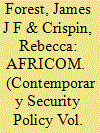

|
|
|
|
|
| Publication |
2009.
|
| Summary/Abstract |
Officially activated on 1 October 2008, US Africa Command (AFRICOM) is first and foremost an internal consolidation and reorganization of Defense Department personnel. Its primary mission is to help Africans address their security challenges. AFRICOMdiffers from other Defense Department organizations by focusing primarily on activities that contribute not to warfighting, but war prevention. Even so, it has struggled with controversy since its inception. The views of key constituencies range from lukewarm acceptance to outright hostility. The central lesson from this research is that the views of foreign audiences toward American foreign policies have a direct impact on the success of those policies. One of its most difficult tasks will be convincing key audiences - African governments and militaries, NGOs, international media, and not least other US government agencies and the Congress - that the effort and funding put into this command were worthwhile and should continue. Confusion still remains over exactly what AFRICOM is and what it wants to do. Sorting this out will require consulting, listening, and learning. Its leaders must develop and lead a new type of organization that runs counter to traditional instincts of senior personnel in the Department of Defense who continue to resist the notion of interagency coordination. In sum, we remain hopeful that the past need not predict the future of American policies in Africa.
|
|
|
|
|
|
|
|
|
|
|
|
|
|
|
|
| 2 |
ID:
134217
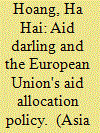

|
|
|
|
|
| Publication |
2014.
|
| Summary/Abstract |
This paper analyses the motivation determining the European Union's (EU) aid allocation to Vietnam. Existing literature and EU official documents are used to build upon four models with respect to new aid allocation: donor interest, recipient interest, recipient capacity and potential donor influence. The paper concludes that the EU's aid policy in Vietnam has a long-term objective in conformity with Vietnam's development strategy-poverty alleviation. Moreover, the EU's political and economic interests, a successful economic reform and development strategy, a high level of ownership (good governance) and potential donor influence are identified as contributions to make Vietnam an 'aid darling'.
|
|
|
|
|
|
|
|
|
|
|
|
|
|
|
|
| 3 |
ID:
133411
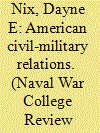

|
|
|
|
|
| Publication |
2012.
|
| Summary/Abstract |
Samuel P. Huntington died in December 2008, but this Harvard academic continues to have a significant impact on the conduct and state of American civil-military relations. Mackubin Owens's recent US Civil-Military Relations after 9/11: Renegotiating the Civil-Military Bargain and Suzanne Nielsen and Don M. Snider's 2009 edited work American Civil-Military Relations: The Soldier and the State in a New Era both challenge and contextualize Huntington's work for contemporary theorists and practitioners of civil-military relations. This is indeed a worthwhile effort, as America's civil-military relations have received much "airtime" over the past few years. General Stanley McChrystal's seeming challenge to the political leadership over proposed Afghanistan troop levels, Lieutenant Colonel Andrew Milburn's Joint Force Quarterly article challenging traditional conceptions of civilian control, and Bob Woodward's revelations in Obama's War regarding the 2009 tensions between the Pentagon and the administration over Afghanistan strategy highlight the relationship between the military and our civilian leaders while raising the issue of the military's participation in political discourse.
|
|
|
|
|
|
|
|
|
|
|
|
|
|
|
|
| 4 |
ID:
139076
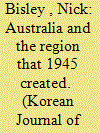

|
|
|
|
|
| Summary/Abstract |
This paper examines the importance of the postwar settlement to Australian international policy. In particular, it considers how the postwar settlement of American regional primacy and economic dominance became built into the foundations of Australian international engagement and its long-term consequences. The first part of the paper explains how this occurred and why it is so important to Australia’s current policy dilemmas. The second part of the paper examines how changes to the fundamental structures of the 1945 regional strategic settlement, focusing primarily on Northeast Asia, are driving shifts in Australian policy. It concludes with a reflection on the choices Australia has made about its strategic future as it is heavily invested in the belief that U.S. primacy can endure over the long term.
|
|
|
|
|
|
|
|
|
|
|
|
|
|
|
|
| 5 |
ID:
130702
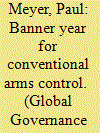

|
|
|
|
|
| Publication |
2014.
|
| Summary/Abstract |
THE CONTROL OF CONVENTIONAL ARMS HAS OFTEN SEEMED THE POOR COUSIN of the global efforts to control weapons of mass destruction (WMD). Since the advent of the atomic era, the focus of arms control and disarmament activity has been overwhelmingly on nuclear weapons and their lesser, if still ugly, stepsisters of biological and chemical weapons. The initial multilateral arms control agreements concerned themselves with limits on the testing of nuclear weapons and, shortly thereafter, with their nonproliferation (e.g., the Nuclear Nonproliferation Treaty of 1968). Bilateral US-Soviet/Russian arms control arrangements also predominantly dealt with the reduction of strategic nuclear forces and restraints on deployments of defenses against (nuclear tipped) ballistic missiles. Efforts to reduce major conventional weapon systems were also taken up in the 1980s in the context of negotiations
between the opposing alliances of NATO and the Warsaw Pact, eventually culminating in the Treaty on Conventional Forces in Europe (CFE Treaty) of 1989. This treaty provided for a massive reduction in the conventional forces that had confronted each other for years in Central Europe and established a new, far more stable security order on the continent. Even the CFE Treaty, however, tended to be overshadowed by other major disarmament agreements concluded in those heady post-Cold War days: the Intermediate Nuclear Forces Treaty (1987), Chemical Weapons Convention (1993), Comprehensive (Nuclear) Test Ban Treaty (1996), and various US-Russian bilateral strategic nuclear arms accords of the 1990s and early 2000s (e.g., the Strategic Arms Reduction Treaty and the Strategic Offensive Reductions Treaty).
|
|
|
|
|
|
|
|
|
|
|
|
|
|
|
|
| 6 |
ID:
133045
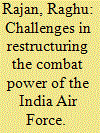

|
|
|
|
|
| Publication |
2014.
|
| Summary/Abstract |
The IAF's capability covers the IOR counties on the maritime side and its principal adversaries Pakistan and China on the landward side
|
|
|
|
|
|
|
|
|
|
|
|
|
|
|
|
| 7 |
ID:
129692
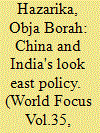

|
|
|
|
|
| Publication |
2014.
|
| Summary/Abstract |
Look East policy was initiated in 1991, it marked a strategic shift in India's perspective of the world. It coincided with the beginning of our economic reform process and provided an opportunity for significantly enlarging our economic engagement. At the same time it also encouraged a renewal of linkages with our civilizationnal neighbors in South East and East Asia.
India's look East policy was more than an economic imperative. It was a significant shift in India's vision of the world and her place in the emerging post-Cold war global scenario. In the years to come it will be our endeavour to strengthen political, physical and economic connectivity between India and East Asia and broaden the underpinnings of our quest for peace and prosperity.
|
|
|
|
|
|
|
|
|
|
|
|
|
|
|
|
| 8 |
ID:
122752
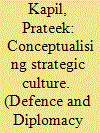

|
|
|
| 9 |
ID:
105594
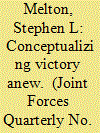

|
|
|
| 10 |
ID:
133899
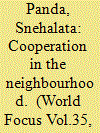

|
|
|
|
|
| Publication |
2014.
|
| Summary/Abstract |
Integration with global market economy expanded India's relationship with a wide range of countries across continents. It should be sustained and expanded along with the regional cooperation forums to strengthen economy and territorial as well as human security.(38) SAARC is the first in the series of regional cooperation organizations preceding economic reforms in India. At the moment except ASEAN and BRICS all other institutions have a lackluster performance.
|
|
|
|
|
|
|
|
|
|
|
|
|
|
|
|
| 11 |
ID:
172231
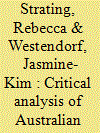

|
|
|
| 12 |
ID:
127622
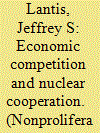

|
|
|
|
|
| Publication |
2014.
|
| Summary/Abstract |
The number of bilateral nuclear cooperation agreements surged during the "nuclear renaissance" of the past decade. This proliferation is only partially explained by the prevailing approaches that focus on strategic imperatives. To supplement these explanations, this study draws on neoliberal models of economic competition to posit that bilateral agreement negotiations also exhibit conditions of "uncoordinated interdependence" and maneuvering to gain market share. Case evidence suggests the contours of supplier state bids for civilian assistance are determined at least as much by considerations about economic competition as they are by positive strategic goals. In addition, this study identifies several cases of cooperation where there appears to be little or no strategic motive for export agreements. The study concludes that patterns of economic competition and the influence of peers in defined competitive spaces alter material payoffs and impact policies. It also identifies a surprising role for principled restraint in dampening strategic and economic competition in some dyads.
|
|
|
|
|
|
|
|
|
|
|
|
|
|
|
|
| 13 |
ID:
190709
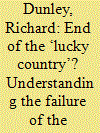

|
|
|
|
|
| Summary/Abstract |
The Australian debate over AUKUS, and its strategic policy more generally, has been notable for its disjointed and incoherent nature. This article seeks to explain why, arguing that Australia has been the beneficiary of a remarkably benign strategic situation for nearly 80 years, something that has distorted our understanding of the underlying landscape.
|
|
|
|
|
|
|
|
|
|
|
|
|
|
|
|
| 14 |
ID:
192083
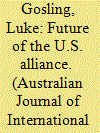

|
|
|
|
|
| Summary/Abstract |
One of the most successful defence pacts in history, Australia’s alliance with America is becoming ever more central to our strategic policy. This is a bipartisan trend that has been supported by previous governments, including in the Morrison government’s 2020 Defence Strategic Update, and is being implemented by the Albanese government, as confirmed in its 2023 Defence Strategic Review. At the same time, successive U.S. administrations have refocussed on the Indo-Pacific despite competing strategic priorities in other regions, including the Ukraine war. This has led to Australia and America pursuing a policy of deeper integration of their armed forces at the operational and strategic levels. This is most visible in northern Australia, whose value to Australian and allied defence planning is increasing for geopolitical reasons. Building on the Marine rotational force in Darwin announced in President Obama’s pivot to Asia, U.S. force posture initiatives are upgrading northern Australian defence infrastructure and deploying additional forces for exercises and contingency planning at a time when Australia is also investing in its northern bases. While cutting-edge capabilities such as SSN-AUKUS submarines will boost Australia’s strategic contribution to the alliance, its strength lies in the solid public support it enjoys.
|
|
|
|
|
|
|
|
|
|
|
|
|
|
|
|
| 15 |
ID:
072813
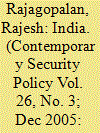

|
|
|
|
|
| Publication |
2005.
|
| Summary/Abstract |
India has been pursuing missile defences for a decade. Its missile defence programme is determined more by political than military imperatives, and it appears to be driven primarily by concerns about the threat posed by Pakistan's missile force, with little direct consideration of China. There is little indication that Indian decision-makers have thought through the kind of missile defence architecture that is needed for this emerging requirement, or the political implications of deploying a missile defence system. India's democratic polity has had little influence on decision-making on missile defences, though this is by itself not unusual since strategic policy has rarely invoked much interest or debate in India. But missile defences also sit uneasily with or even contradict other aspects of India's nuclear doctrine, and these contradictions have not yet been addressed.
|
|
|
|
|
|
|
|
|
|
|
|
|
|
|
|
| 16 |
ID:
132558
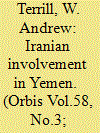

|
|
|
|
|
| Publication |
2014.
|
| Summary/Abstract |
For at least a decade, there have been numerous Yemeni, Saudi, and other countries' assertions that Iran has been involved in supporting northern Yemeni rebels seeking autonomy from the Sana'a government. Iranian diplomatic and political support for this rebellious group (known as the Houthis) is undeniable, but Iranian military assistance for them has not always been easy to prove. This situation appeared to change in 2011 when Iran's increased involvement in Yemen occurred in response to both the chaotic situation there during the final year of the Saleh regime and the danger that the Arab Spring revolutions would leave Iran increasingly isolated. Evidence of Iranian efforts to supply weapons to the Houthis now seems overwhelming in contrast to uncertain reports prior to 2011. In addition, at least some of Yemen's southern secessionists also appear to be receiving at least limited Iranian financial support.
|
|
|
|
|
|
|
|
|
|
|
|
|
|
|
|
| 17 |
ID:
132791
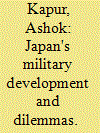

|
|
|
|
|
| Publication |
2014.
|
| Summary/Abstract |
Japan merits serious study as a diplomatic and strategic power in the twenty-first century for several reasons. Although her population size is declining because of shrinking birth rates and restrictive immigration, the ratio of seniors is increasing --with increasing demands for pensions and state-supported safety nets - and the number of younger participants in the growth of her economy and public life is declining, the Japanese people have demonstrated a high degree of discipline and internal social cohesion at times of war, peace and crisis. An example is their fortitude during the recent (2011) nuclear and tsunami disasters. After 1945, her social and political values stress the importance of harmony and consensus building in her domestic arrangements, and the Japanese people and ruling elites value rejection of war as the sovereign right of the Japanese state. For this reason, domestic public opinion matters in the making and orientation of Japan 's external policies following her defeat in 1945 and with the establishment of a pacifist constitution and constitutional democracy. The population is not easily swayed by radical political and nationalistic rhetoric, even though in recent years, nationalist sentiment has grown in Japan and this was signalled by the election of Prime Minister S/2in;o Abe (2012). Still, despite the centre-right tilt in Japanese public and elite opinion in recent years, the Japanese people demand a thorough assessment of new moves to shift strategic policy and constitutional arrangements on defence issues.
|
|
|
|
|
|
|
|
|
|
|
|
|
|
|
|
| 18 |
ID:
128261
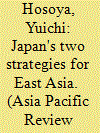

|
|
|
|
|
| Publication |
2013.
|
| Summary/Abstract |
For much of its postwar history, Japan's diplomacy consisted of three pillars: "the United Nations Centrism," "cooperation with free countries," and "being a member of Asia." However, beginning in the twenty-first century, two new diplomatic strategies for East Asia have emerged. These two paths exhibit different philosophies which however share some elements. This article examines the "East Asian Community" vision and the "Arc of Freedom and Prosperity" initiative and identifies the key concepts that they share. Finally, it suggests that if Japan's two foreign policy visions were unified, the strategy would be strengthened.
|
|
|
|
|
|
|
|
|
|
|
|
|
|
|
|
| 19 |
ID:
130293
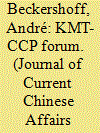

|
|
|
|
|
| Publication |
2014.
|
| Summary/Abstract |
The recent rapprochement between China and Taiwan cannot be understood if our conceptual apparatus is unable to cope with the distinctive new quality of cross-Strait relations. A critical framework provides a transnational account of cross-Strait dynamics. An analysis of the KMT-CCP Forum through the lens of the neo-Gramscian notion of hegemony sheds light on the Forum's strategies, mechanisms, practices and instruments to secure consent for cross-Strait rapprochement. While this mode of governance has broadened the KMT's strategic options, it has also compromised Taiwanese democracy.
|
|
|
|
|
|
|
|
|
|
|
|
|
|
|
|
| 20 |
ID:
172233
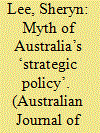

|
|
|
|
|
| Summary/Abstract |
Does Australia have a ‘strategic policy’? Australia’s debate has seen an inflation of the use of the term ‘strategic policy’, often used synonymously with ‘defence policy’ and ‘strategic guidance’ to indicate a major policy or to simply describe Australia’s strategic environment. However, far from pure semantics, the term ‘strategic policy’ has become dissociated from the specific understanding of the policy objectives attached to the use and the threat of the use of military force. Instead, contemporary usage of ‘strategic policy’ has come to reflect what Everett Carl Dolman called a ‘favourable continuation of events’, reducing strategy to a mere functional adjective. Moreover, a focus on ‘policy’ as meeting the objectives of a state, as opposed to ‘politik’, which encompasses policy, politics and the polity, has led to the restriction on choices and objectives for Canberra. In an increasingly contested Asia, the Australian debate should avoid the obfuscation that comes with a term such as ‘strategic policy’ as this can have negative implications for Australian force structure and planning. More broadly, the application of the term ‘strategic policy’ reflects the challenge of Australia as a medium-sized power developing an independent strategy in the context of its history, geography, politics and society.
|
|
|
|
|
|
|
|
|
|
|
|
|
|
|
|
|
|
|
|
|